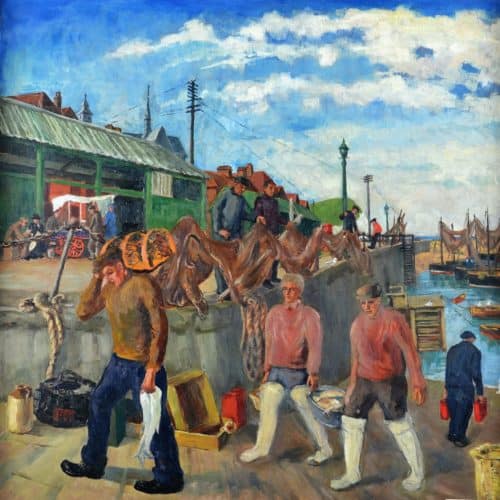Maritime activity 1: Folkestone Harbour - create a family-friendly trail
Pupils research the history of Folkestone Harbour using the Learning from Objects website as a starting point. They visit Folkestone Museum, the harbour and Folkestone Fishing Heritage and History Museum (all within a short walk of each other) to gather more evidence, which they use to create a family-friendly trail.
Learning objectives
Increased knowledge and understanding of the history of Folkestone harbour.
Research skills through internet research and visit to a historic site.
How to design a trail to meet the needs of a target audience.
Skills and confidence in using and creating maps
Curriculum links
KS1-2 History (Local History Study).
KS1-3 English (write the text for a family-friendly trail)
KS1-3 Art and Design (trail illustrations, graphic design)
KS1-3 ICT (design a Smartphone trail)
Divide the class into design teams of 4-6 children.
Inform them that they have been given the important role of creating a new family-friendly history trail to link Folkestone’s historic harbour with its wonderful museum.
The brief is that the trail should…
- Appeal to families with children age 5-11
- Be colourful, exciting and interactive
- Include lots of images and fun facts
- Include challenges or things to find or explore
- Bring to life the history and heritage of this special area
- Involve adults as well as children
- Take no more than an hour to complete (not counting looking round Folkestone Museum)
- Include health and safety advice (about not going near the harbour edge and when crossing busy roads)
- Include info on how to get there by bike, public transport and car. And info on nearest toilets and accessible toilets, and places you can get food, or picnic.
- Follow a clear numbered route (with a map)
- Have accessible (easy to read) text
They should include the following venues in the trail:
- Folkestone Museum (stories, paintings and artefacts from the harbour, and interactive games)
- The Old High Street (as link between the two sites)
- The Stade and Fishmarket
- Folkestone Fishing Heritage Museum (optional)
- The bridge over the harbour (now a pedestrian route)
- Folkestone Harbour Railway Station
- The Harbour Arm
The children plan their trail in advance, and then gather more information, walk the route and take photographs on an exciting site visit, starting at the museum. Please book in advance.
After the museum visit, the children walk down to the harbour to explore the old fishing quarter of The Stade, and the Harbour Arm (where cross-Channel ships berthed) and which includes the site of the WW1 Harbour Canteen.
Content for the trail might include some of the following:
- Folkestone as a medieval Limb of the Cinque Ports
- Failed plans to build a harbour under King Henry VIII
- the building of Folkestone Harbour by Thomas Telford (1809-10)
- the lives of Folkestone fishermen and their families
- Fishermen’s houses on The Stade
- The Fishmarket (see The Dogfish Season painting)
- The coming of the railway in 1843
- Victorian Folkestone as the main cross-Channel port
- the exhibition of a giant whale in Victorian times
- the arrival of the Belgian Refugees in 1914
- troops leaving for France and the Harbour Canteen in WW1
- The arrival of Gandhi in 1931
- Evacuation of Dunkirk in 1940
- First car ferry to France 1946
- High-speed Seacat hydrofoil from Folkestone to Boulogne (1993-2000)
- The Russian submarine tourist attraction (1990s to early 2000s)
- Transforming the Harbour Arm into a modern tourist destination
- Anthony Gormley statue and other art installations
There is accessible information and images for the majority of the above topics on the Learn with Objects website.
Children work in teams to research and create their own historic family trail around Folkestone Harbour, linking it via the Old High Street to Folkestone Museum.
The trail can either be a printed version for visitors to carry round with them (suggest 1 sheet A3 paper, folded to make a 4 page trail, with a map on the back page), or a digital trail for them to use on their smart phone.
Research can be done in advance in the classroom, using Learn with Objects and other websites, but should also include a site visit to gather evidence.
It might include images and artefacts from Learn with Objects. A digital version could also include interviews with experts, and film clips of items of interest at the harbour and Folkestone Museum.
Completed trails can be printed and distributed in book bags to all the families of children in your school so they can enjoy a visit.
It may also be possible to have the trails made available for download as pdfs from the Folkestone Museum website. Please contact the museum team to discuss this exciting opportunity.
Learn with Objects links
There’s a wealth of evidence about Folkestone Harbour on the Learning from Objects website. See topics: Maritime 1, 4, 11. Seaside holidays 10, 13, 15, 18. World War One 1, 2. World War Two 1, 10.

